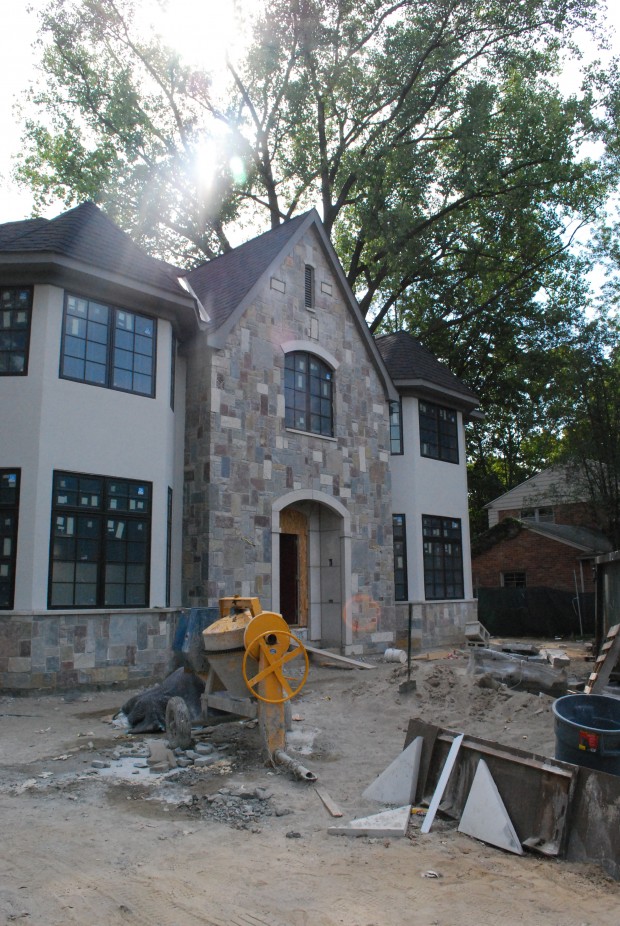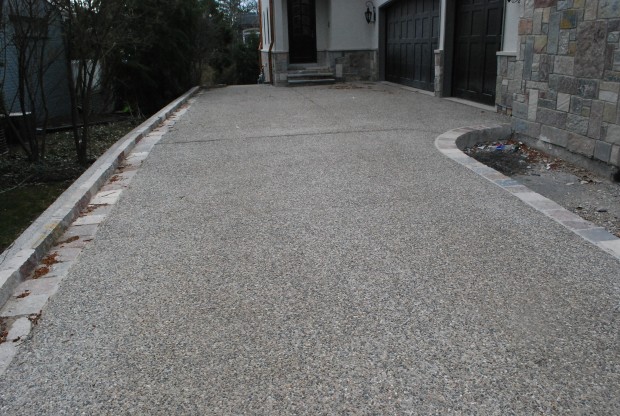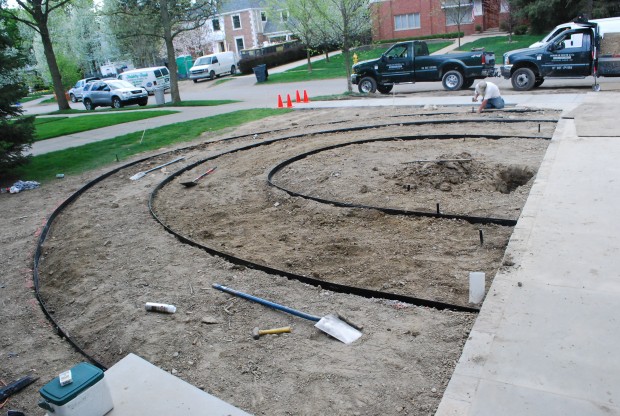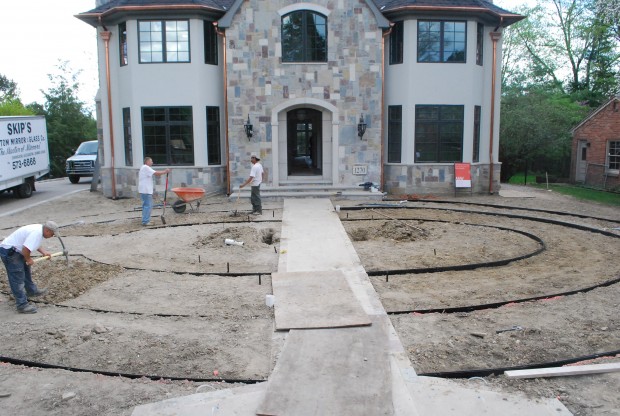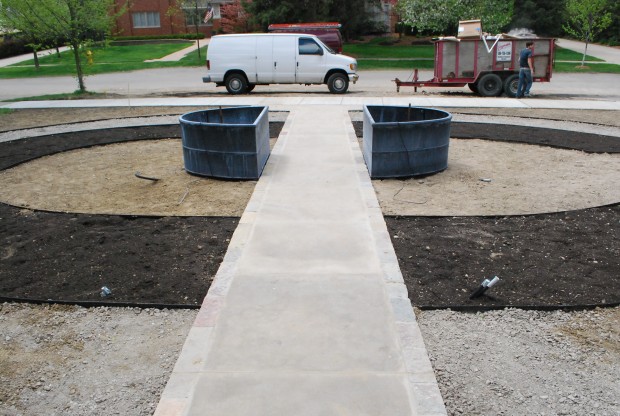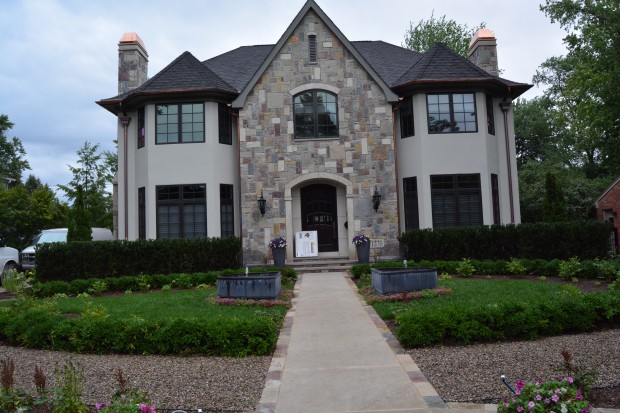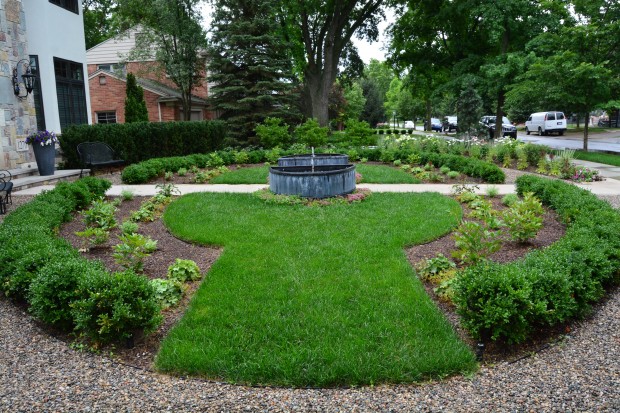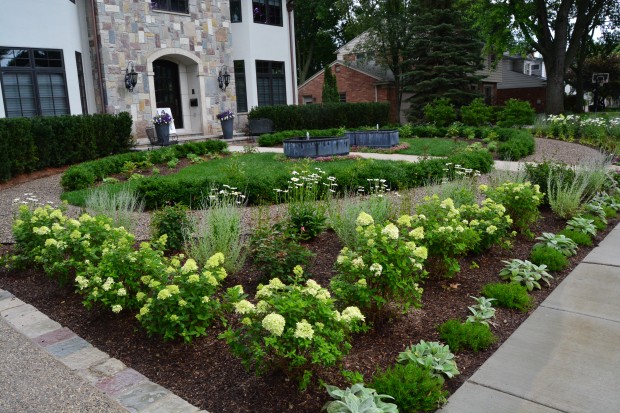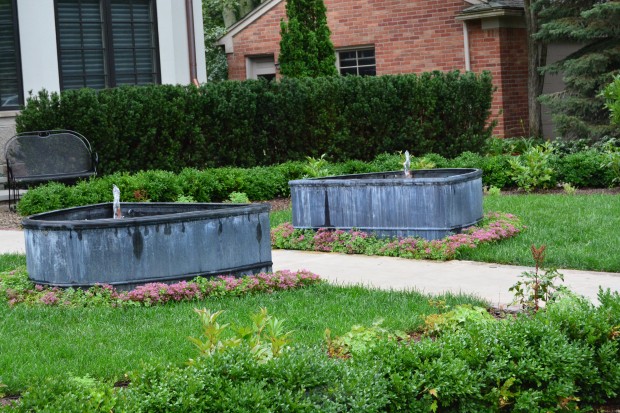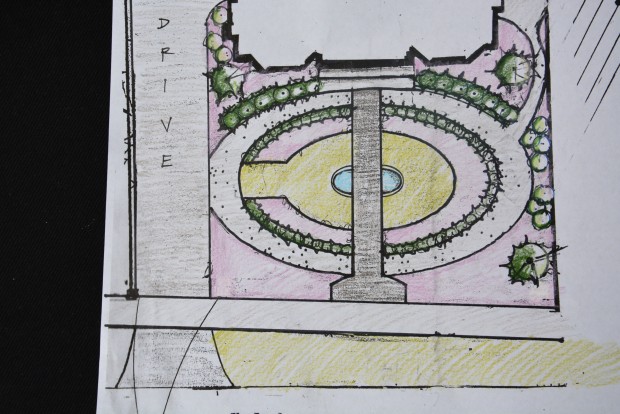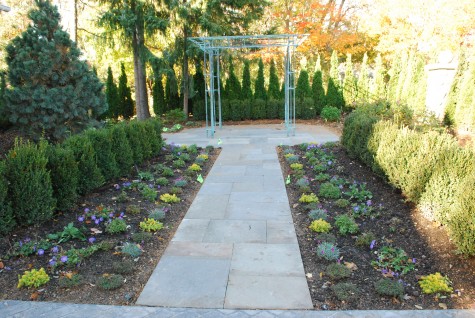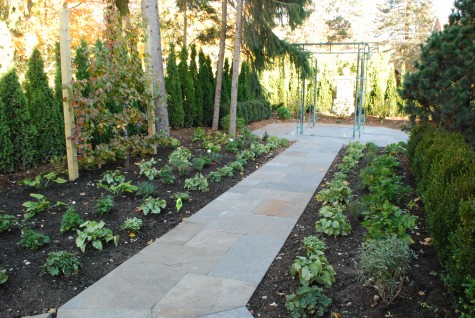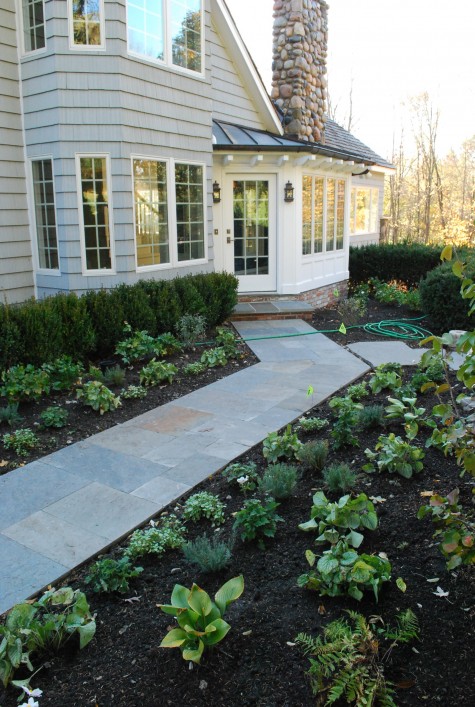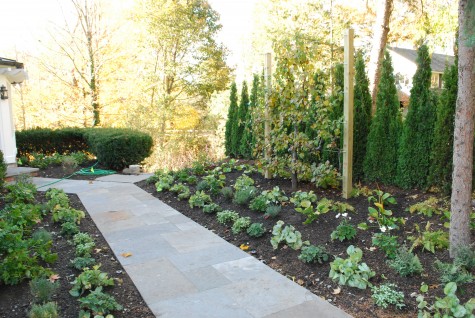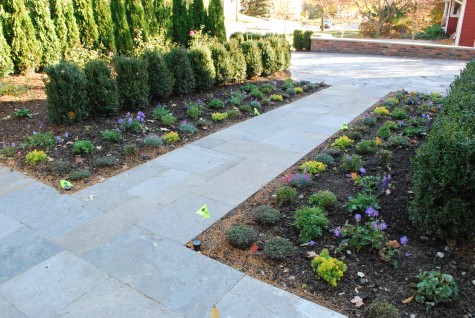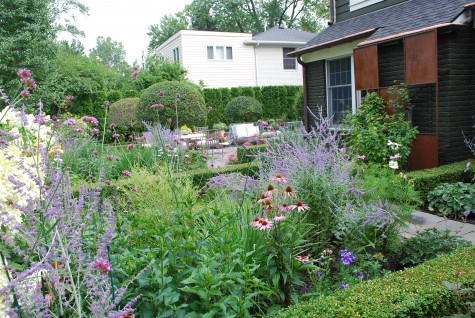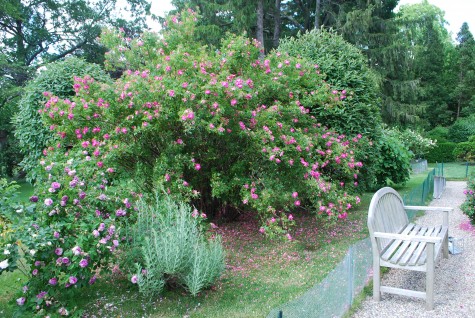 The focus of the landscape in the rear yard was and still is the pond. The informally planted pond gardens, surrounded by old scotch pines and punctuated by a small barn, look and feel as though they have reached a mature state of natural equilibrium. I am not fooled. A devoted gardener created this garden, and spends lots of time and effort caring for it. The new garden pictured above occupies the mid ground space, which separates the formal pool deck from the sprawling pond landscape. Since this garden will primarily be viewed from above, a collection of equally small growing perennials will feature the flowers, framed by foliage.
The focus of the landscape in the rear yard was and still is the pond. The informally planted pond gardens, surrounded by old scotch pines and punctuated by a small barn, look and feel as though they have reached a mature state of natural equilibrium. I am not fooled. A devoted gardener created this garden, and spends lots of time and effort caring for it. The new garden pictured above occupies the mid ground space, which separates the formal pool deck from the sprawling pond landscape. Since this garden will primarily be viewed from above, a collection of equally small growing perennials will feature the flowers, framed by foliage.
 The arrangement of the different varieties is informal and random. The modest height of the plants will not obstruct the view to the pond. The bed is anchored by the dwarf white hydrangea, “Bombshell. The firepit garden includes hemerocallis “Citron”, an Al Goldner variety, and amsonia heubrechtii. The bed on the near side of the stone walk from the pool deck to the pond (not yet installed) is planted with small growing shrubs- spirea “Tor”, rhus aromatica “Gro-Low”, and clethra Ruby Spice.
The arrangement of the different varieties is informal and random. The modest height of the plants will not obstruct the view to the pond. The bed is anchored by the dwarf white hydrangea, “Bombshell. The firepit garden includes hemerocallis “Citron”, an Al Goldner variety, and amsonia heubrechtii. The bed on the near side of the stone walk from the pool deck to the pond (not yet installed) is planted with small growing shrubs- spirea “Tor”, rhus aromatica “Gro-Low”, and clethra Ruby Spice.
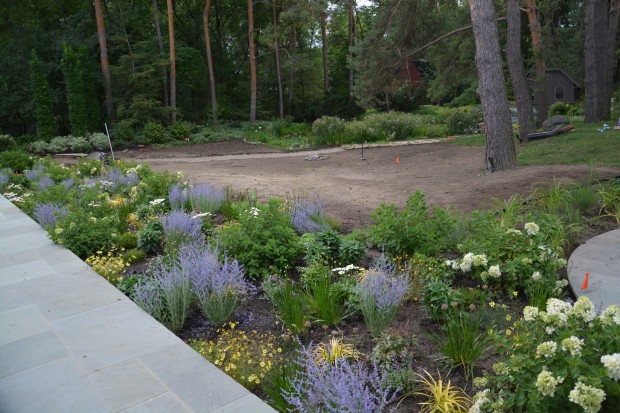
Perennial cultivars include alchemilla mollis, astilbe “Fanal”, Buddleia “Lilac Chip”, Leucanthemum “Snowcap”, Coreopsis “Moonbeam, perovskia “Peek-a-Boo”, Geranium “Tiny Monster”, Carex “Emerillo”, lavender and blue moss phlox, allium “Millenium”, nepeta “Persian Blue” and monarda “Grand Parade”.
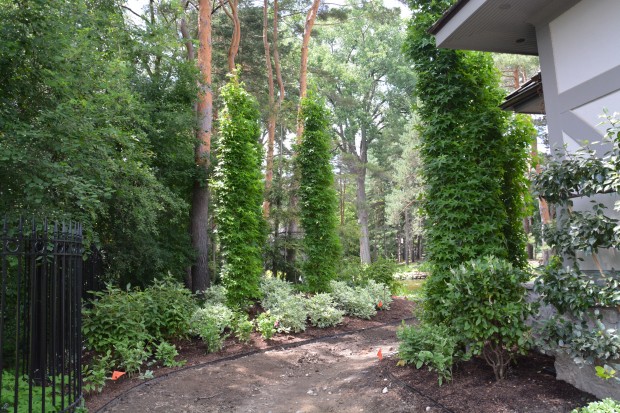 Turning the corner from the south side garden to the rear yard, a group of columnar liquidambar “Slender Silhouette” frames the view to come. Viburnum “Shasta”, viburnum “Mohican”, aesculus parviflora, and variegated red twig dogwood are underplanted with variegated solomon’s seal, and epimedium “Frohn Leiten”.
Turning the corner from the south side garden to the rear yard, a group of columnar liquidambar “Slender Silhouette” frames the view to come. Viburnum “Shasta”, viburnum “Mohican”, aesculus parviflora, and variegated red twig dogwood are underplanted with variegated solomon’s seal, and epimedium “Frohn Leiten”.
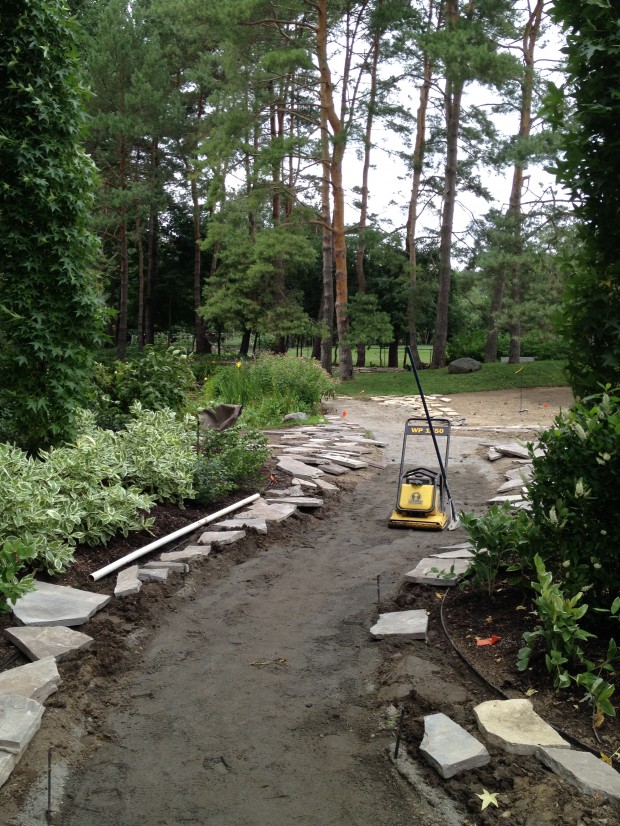 The columnar sweet gum is a great choice for a tree of substance that will grow comfortably in a small and narrow space. The informally growing shrubs bring the pond garden to the foreground, and smooth the visual transition from the more formal house gardens towards the pond.
The columnar sweet gum is a great choice for a tree of substance that will grow comfortably in a small and narrow space. The informally growing shrubs bring the pond garden to the foreground, and smooth the visual transition from the more formal house gardens towards the pond.
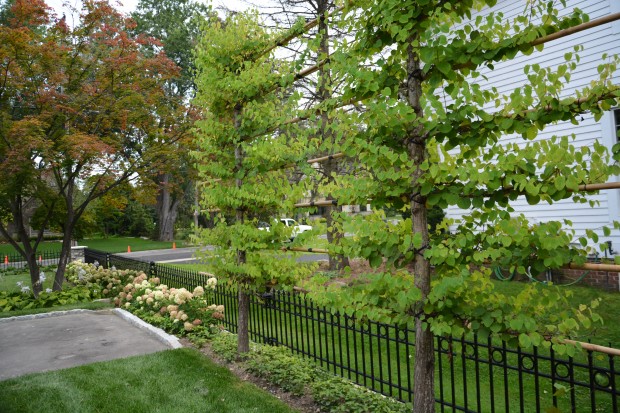 The landscape has 12 espaliered trees. 8 katsuras provide a lot of screening on both the north and south lot lines without taking up much in the way of space. These espaliers will be grown into and maintained as a solid green wall. The north and south perimeter of the front yard landscape is planted with hydrangea “Little Lime”. Small properties ask for plant material small and narrow in scale. A pair of old silver maples in the tree lawn had to be removed. Giant girdling roots eventually did them in. We replaced the street trees with honey locusts. Though they fill the bill as street trees, their canopy is open growing, and their roots are friendly to the well being of companion plants.
The landscape has 12 espaliered trees. 8 katsuras provide a lot of screening on both the north and south lot lines without taking up much in the way of space. These espaliers will be grown into and maintained as a solid green wall. The north and south perimeter of the front yard landscape is planted with hydrangea “Little Lime”. Small properties ask for plant material small and narrow in scale. A pair of old silver maples in the tree lawn had to be removed. Giant girdling roots eventually did them in. We replaced the street trees with honey locusts. Though they fill the bill as street trees, their canopy is open growing, and their roots are friendly to the well being of companion plants.
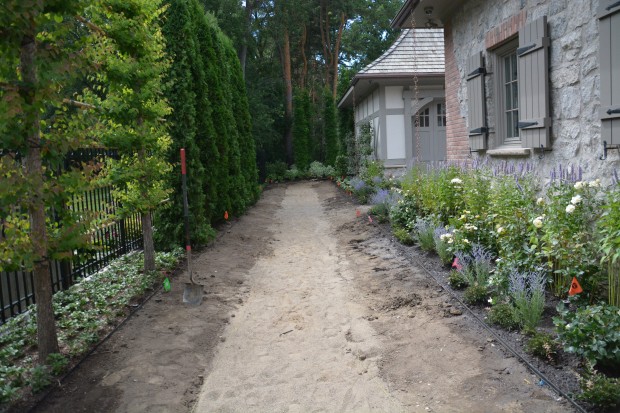 The south side garden includes fruiting pear trees, and a run of arborvitae, planted for privacy. The garden includes Macy’s Pride rose, Sunny knockout rose, hyssop, astilbe “Sprite, and the dwarf Russian sage, “Peek-a-Boo”. Towards the rear, the pear espaliers are underplanted with brunnera “Jack Frost”, and pachysandra.
The south side garden includes fruiting pear trees, and a run of arborvitae, planted for privacy. The garden includes Macy’s Pride rose, Sunny knockout rose, hyssop, astilbe “Sprite, and the dwarf Russian sage, “Peek-a-Boo”. Towards the rear, the pear espaliers are underplanted with brunnera “Jack Frost”, and pachysandra.
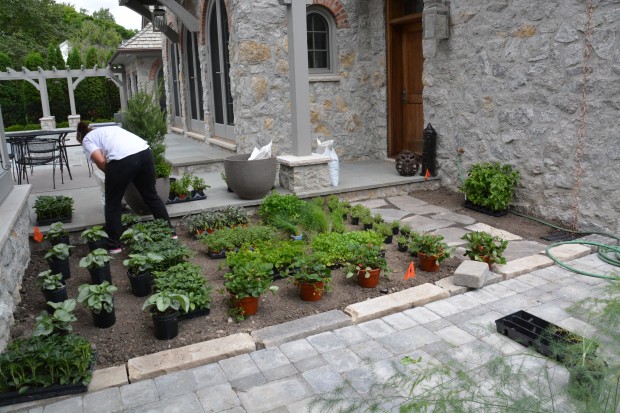 The brunnera wraps around the side, where the garden is shaded by an overhang. The sunnier areas are planted with herbs, both perennial and annual. Pots were added at the last for tomatoes, and flowers.
The brunnera wraps around the side, where the garden is shaded by an overhang. The sunnier areas are planted with herbs, both perennial and annual. Pots were added at the last for tomatoes, and flowers.
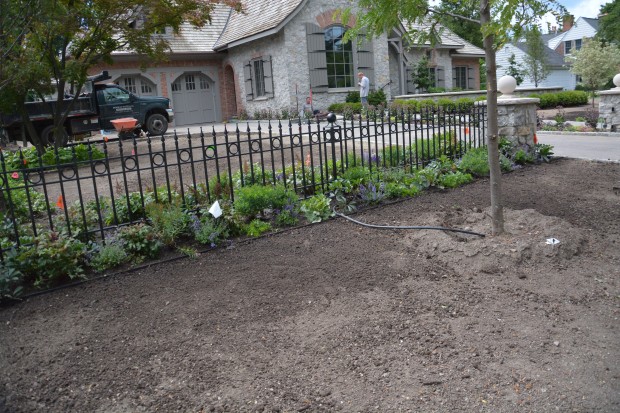 In the front yard, a garden was planned for both sides of the iron fence. Given the low height of the fence, the perennials are correspondingly short. The garden is anchored with a number of helleborus “Jacob”. Added to this, more dwarf buddleia, anemone “Snowdrop”, sweet woodriff, aster “Wood’s Blue”, Salvia “Marcus, heuchera “Venus”and Euphorbia polychroma. This garden will be planted with small spring flowering bulbs this coming month.
In the front yard, a garden was planned for both sides of the iron fence. Given the low height of the fence, the perennials are correspondingly short. The garden is anchored with a number of helleborus “Jacob”. Added to this, more dwarf buddleia, anemone “Snowdrop”, sweet woodriff, aster “Wood’s Blue”, Salvia “Marcus, heuchera “Venus”and Euphorbia polychroma. This garden will be planted with small spring flowering bulbs this coming month.
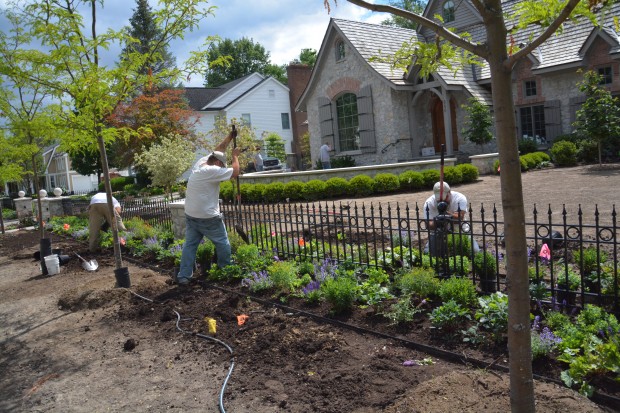 The fence actually follows the line set by the sidewalk, which is not parallel to the house. This width of the garden on either side of the fence varies depending on the location. This helps to create the impression that the fence runs parallel to the house. Why would I think this was important? This space is more formally designed. I am usually reluctant to plant perennial gardens in a front yard. If I do plant them there, I like the effect to be compact and tailored-not a look that nature is particularly inclined to. Perennial gardens only look as good as the quality of the maintenance devoted to them. But this client loves, and looks after her gardens.
The fence actually follows the line set by the sidewalk, which is not parallel to the house. This width of the garden on either side of the fence varies depending on the location. This helps to create the impression that the fence runs parallel to the house. Why would I think this was important? This space is more formally designed. I am usually reluctant to plant perennial gardens in a front yard. If I do plant them there, I like the effect to be compact and tailored-not a look that nature is particularly inclined to. Perennial gardens only look as good as the quality of the maintenance devoted to them. But this client loves, and looks after her gardens.
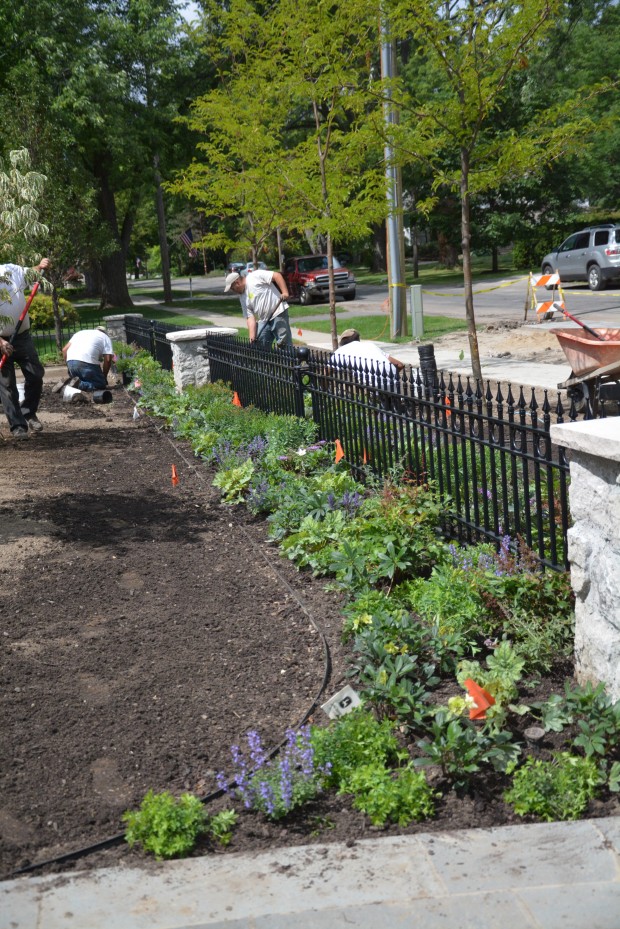 This garden also solves the issue of how the fence interacts with the landscape. Mulch or stone under the fence-rather bleak. Grass up to the fence is very difficult to maintain in a beautiful way. This fence is an architectural feature of the yard-the garden says so.
This garden also solves the issue of how the fence interacts with the landscape. Mulch or stone under the fence-rather bleak. Grass up to the fence is very difficult to maintain in a beautiful way. This fence is an architectural feature of the yard-the garden says so.
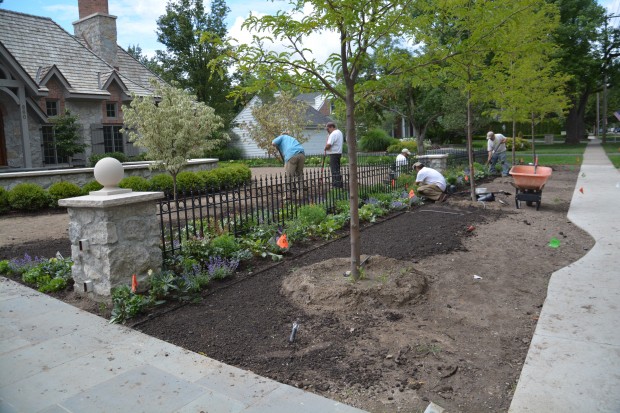 The front yard features two types of dogwoods. A pair of cornus kousa “Venus” will growing to a height of about 15 feet, and features large white flowers in June. A pair of variegated cornus kousa “Samaratin” are planted between the boxwood describing the curved stone wall, and the fence garden.
The front yard features two types of dogwoods. A pair of cornus kousa “Venus” will growing to a height of about 15 feet, and features large white flowers in June. A pair of variegated cornus kousa “Samaratin” are planted between the boxwood describing the curved stone wall, and the fence garden.
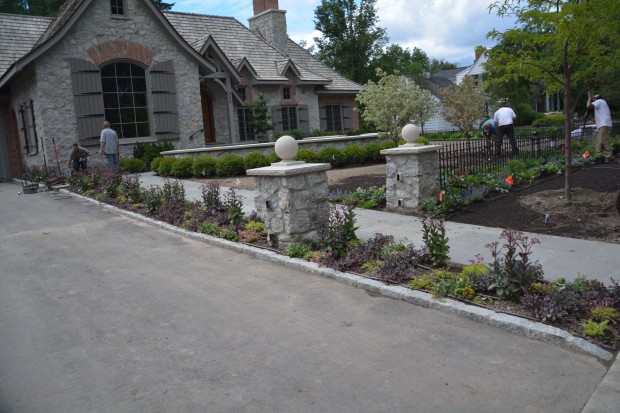 A narrow strip of a bed separates the driveway from the walk to the front door. That garden is entirely comprised of hens and chicks and sedums. Sedum Vera Jamieson, Dazzel Berry, Mr. Goodbud, John Creech, Matrona and angelina were outfitted with drip lines, so they could be watered on an appropriately infrequent schedule.
A narrow strip of a bed separates the driveway from the walk to the front door. That garden is entirely comprised of hens and chicks and sedums. Sedum Vera Jamieson, Dazzel Berry, Mr. Goodbud, John Creech, Matrona and angelina were outfitted with drip lines, so they could be watered on an appropriately infrequent schedule.
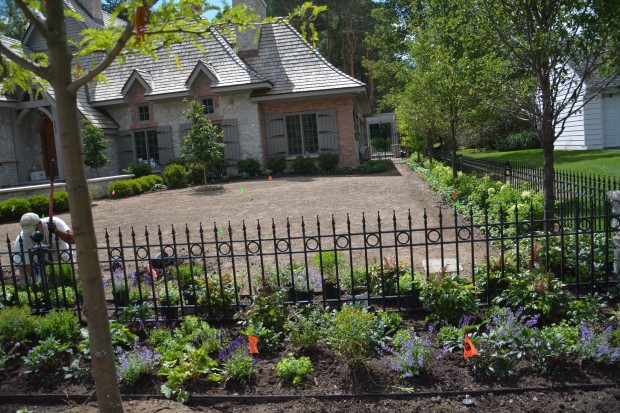 Columnar Bradford pears on the north lot line will provide a little large scale company to the house.
Columnar Bradford pears on the north lot line will provide a little large scale company to the house.
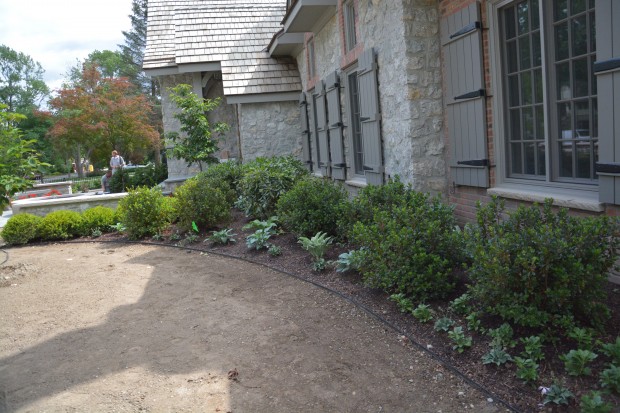 The garden at the front is planted with azalea “Stewartsonii, and a collection of blue leaved hostas of varying sizes. The cultivars include hosta sieboldiana elegans, krossa regal, Halcyon, Regal Splendor, and Mouse Ears. Regal splendor is a krossa regal variety with cream edges. By mt client’s special request, a few rhododendron “Nova Zembla”.
The garden at the front is planted with azalea “Stewartsonii, and a collection of blue leaved hostas of varying sizes. The cultivars include hosta sieboldiana elegans, krossa regal, Halcyon, Regal Splendor, and Mouse Ears. Regal splendor is a krossa regal variety with cream edges. By mt client’s special request, a few rhododendron “Nova Zembla”.
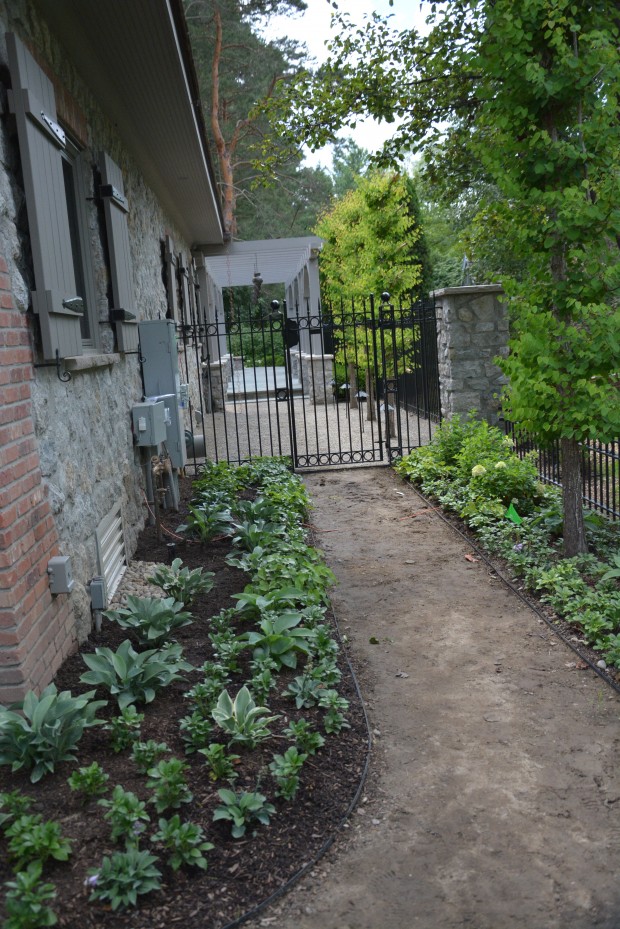 Of course the pool yard has a more serious fence and gate-this is code. But the iron work is light, and permits a glimpse through to the pool terrace pergola.
Of course the pool yard has a more serious fence and gate-this is code. But the iron work is light, and permits a glimpse through to the pool terrace pergola.
 The last of the planting? Due to the location of several underground mechanical boxes, this area could not be planted in ground. A frost proof Belgian stoneware pot would be planted with a dwarf Japanese maple. We will most likely drop-pot the maple, meaning we will drop in into the container, plastic pot and all, for the spring, summer, and fall. The maple will be stored in the garage for the winter. Once in a while I am fortunate enough to have a client who wants a landscape filled with gardens. She has a very special way with plants. This landscape will shine, given her care.
The last of the planting? Due to the location of several underground mechanical boxes, this area could not be planted in ground. A frost proof Belgian stoneware pot would be planted with a dwarf Japanese maple. We will most likely drop-pot the maple, meaning we will drop in into the container, plastic pot and all, for the spring, summer, and fall. The maple will be stored in the garage for the winter. Once in a while I am fortunate enough to have a client who wants a landscape filled with gardens. She has a very special way with plants. This landscape will shine, given her care.
